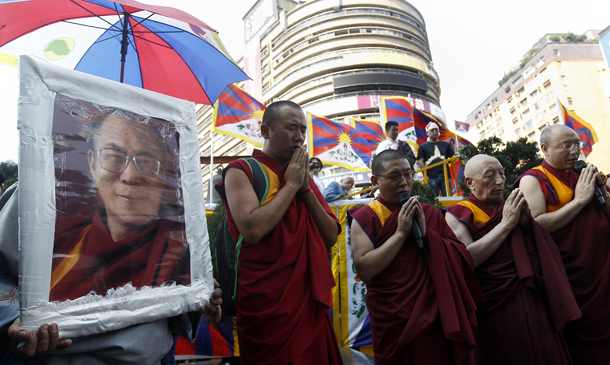Buddhist-led anti-Muslim violence and persecution has received unprecedented mass-media attention in the past couple weeks. Images of Wirathu—monk-leader of the “969” movement, recognized for its hate speech and for inciting violence against Burma’s Muslims—have now graced both the cover of TIME and the front page of The New York Times.

While media attention has been for the most part appreciated by human rights activists, some journalist have criticized undue emphasis on the figure—or figurehead—of Wirathu. Human Rights Watch Executive Director Kenneth Roth countered on Twitter, “Instead of denouncing Time cover story on #Burma Buddhist extremism, why not denounce violence against Muslims?” Although the TIME feature may have had some holes, other media outlets have quickly filled them.
Burmese publication Irrawaddy reported on the largest gathering of monks in Burma in recent years. Fifteen-hundred from across Burma descended on Yangon, the country’s commercial capital, to discuss strategies to resolve tensions between the country’s Buddhist majority and Muslim minority. Senior monks urged others to rally support for a new bill “for the Protection of Race and Religion,” which includes a provision that would put restrictions on interfaith marriage. If enacted, the law would require Buddhist women to gain permission from their parents as well as local government officials in order to marry a Muslim man; Muslim men wedding Buddhists would be required to convert to Buddhism.
The Buddhist ultra-nationalist movement has received official Burmese government endorsement. Reuters reports that although 969 present itself as a grassroots movement, and boasts considerable grassroots support, its origins trace back to the former military dictatorship of “Myanmar”—the name adopted by the military junta. Many senior government officials, including President Thein Sein, were once high-ranking officers in the former military regime. The 969 movement relies on former-regime in addition to support from members of National League for Democracy, headed officially by Nobel Peace Prize leaureate Aung San Suu Kyi.
On Sunday, President Thein Sein issued a statement saying, 969 “is just a symbol of peace” and Wirathu is “a son of Lord Buddha” (via Reuters). Minister of Religious Affairs Sann Sint, a former lieutenant general in the military regime, also expressed his admiration for the extremist movement and its monk-leader.
Violence against Muslims has not only been widely condoned but also in some cases “abetted by local security forces.” The combination of strong grassroots and government support has been a deadly and terrifying combination for the country’s small Muslim population.
“I’m really frightened,” a Muslim vendor told The New York Times. “We tell the children not to go outside unless absolutely necessary.”
*
Yesterday, Human Rights Watch (HRW) published a report presenting forced relocations of Tibetans in China. The government policy of mass rehousing and relocation has affected millions of Tibetans, and radically altered their ways of life. The Chinese government asserts that these operations are entirely voluntary, but HRW contends that this is only the case in a limited instances. Because China refuses to allow independent fact-finding investigations in Tibetan areas, the report relies heavily on open source satellite imagery, which reveals the policy’s drastic physical effect on the landscape.

The report comes in the wake of China’s loosening of policies against freedom of religious expression in Tibet. Just two weeks ago, Chinese officials announced an “abrupt and unexpected reversal of policy” allowing monks in some Tibetan areas to worship the Dalai Lama as a religious leader. Furthermore, the policy document asks monks to refrain from “criticizing the Dalai Lama” and “using such labels as a wolf in a monk’s robes,” an epithet for the Dalai Lama preferred by both Chinese media and Beijing.
‘As a religious person, from now on you should respect and follow His Holiness the 14th Dalai Lama,’ the document continued, ‘but in terms of politics you are not allowed to do so. Politics and religion should go separate ways.’
The policy, likely a response to the more than 100 self-immolations that have been carried out inside Tibet since 2009, is being called an “experiment,” which is how the Party refers to radical policy changes before they are instituted nationwide. China is expected to announce a new, official policy in August.
In addition, Beijing has lifted the 17-year ban on displaying pictured of the Dalai Lama in homes and monasteries in Dram, a town near the Nepali border—likely another “experiment.” The news comes on the eve of China’s forthcoming tour of Tibet by foreign journalists, leading many to suspect the provisional policies nothing more than a “PR push.”
Chinese officials would at least hope to stymy the surge in self-immolations. In an interview with Hong Kong-based Asia Weekly, Jin Wei, a director of ethnic and religious affairs at the Central Party School think-tank in Beijing, suggested that China’s policy in Tibet is failing, and it requires reform. According to journalist Tsering Namgyal, reactions from Tibetan have ranged from “guarded optimism to outright skepticism.”
—Alex Caring-Lobel
Thank you for subscribing to Tricycle! As a nonprofit, we depend on readers like you to keep Buddhist teachings and practices widely available.